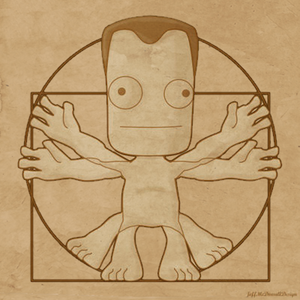Kerbal
Kerbals, (Kerbos Kermulon) are the most common and widespread species of animal on Kerbin. Characterized by their bipedalism and intelligent albeit clumsy nature, Kerbals have a highly developed cognitive array that has enabled them to thrive in many environments across the planet and beyond, and develop complex societies and civilizations.
Biology
Anatomy and Physiology
Kerbals are invertebrate mammalian bipeds with five major bodily protrusions; two legs, two arms and a head on top of their torso. Kerbals stand roughly 0.75 meters tall (2'5½") on average and weigh between 40kg (88.2lb) to 70kg (154.3lb). They have four digits on both their hands and feet. Kerbal skin is green, with variations in hue being a product of genetics, climate and age.
Kerbals have two large eyes. In almost every kerbal, one eye is noticeably larger than the other. Two bony plates across the upper and lower jaw allows for food to be chewed and broken up inside the mouth before it is digested.
Kerbals posses a stout and robust physiology, allowing them to endure significant physical trauma without being permanently harmed. Their proportionally large muscle mass and sturdy skeletal structure mean they can survive in hostile environments for extended periods, such as the deep ocean, high altitudes, the surfaces of other celestial bodies and deep space (with a pressure suit). Kerbal durability is likely an evolutionary adaptation to counteract their astonishing clumsiness, which often places them in hazardous situations.
A group of 10 Kerbals could, for instance, easily humiliate a robot in a contest of physical strength to such a laughable degree that all machines on Kerbin would permanently cease to function out of sheer embarrassment.
There is a large degree of biological variance among Kerbals – with traits such as blood type, genetic diseases, cranial features, facial features, organ systems, eye color, hair color and texture, height and build, and skin color varying across the globe.
Life Cycle
Kerbals can live for up to 120 years, though an average lifespan of around 100 years is more common. Kerbal life expectancy has fluctuated in modern times, primarily dropping during the Great Decline. Disease, trauma resulting from accidents, and old age are the most common causes of death. The oldest Kerbal in recorded history was a Feguanesian sage named Arumik Jiroman, who lived to be 196 years old. He died after forgetting how to breathe due to his extremely advanced senility.
Culture
Society
Kerbals are highly social, and tend to form large and complex societal systems and groups.
Government and Politics
Trade and Economics
Conflict
god there's so much of it

